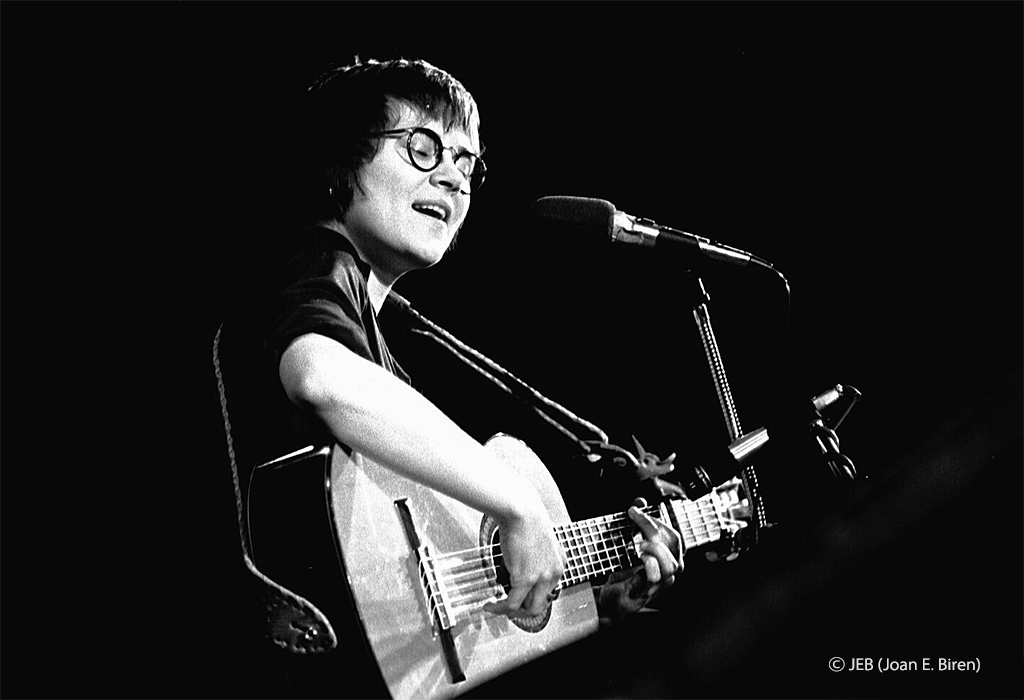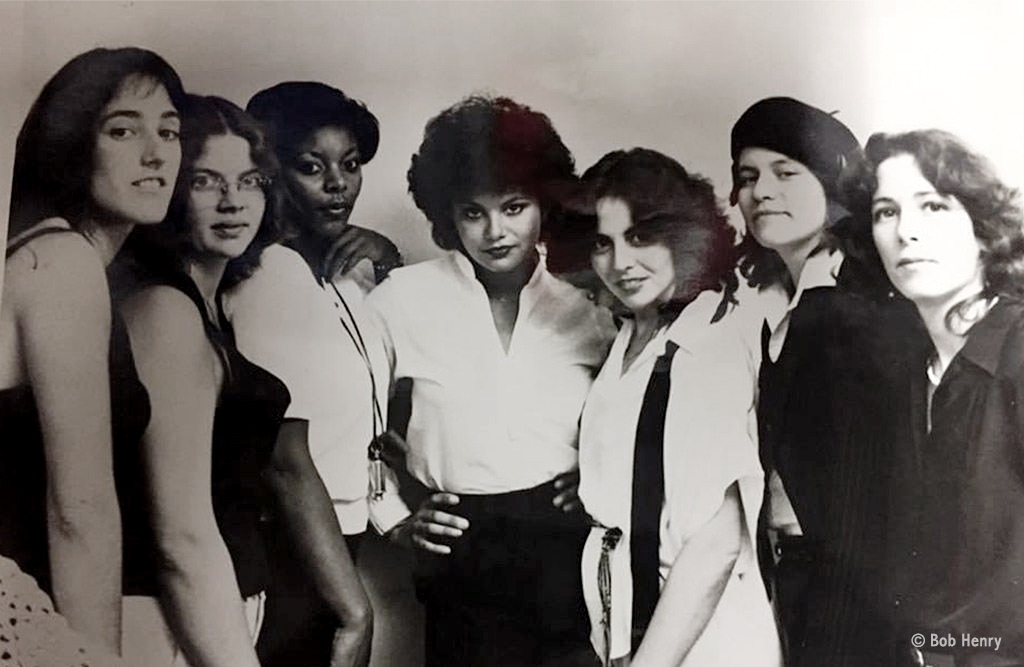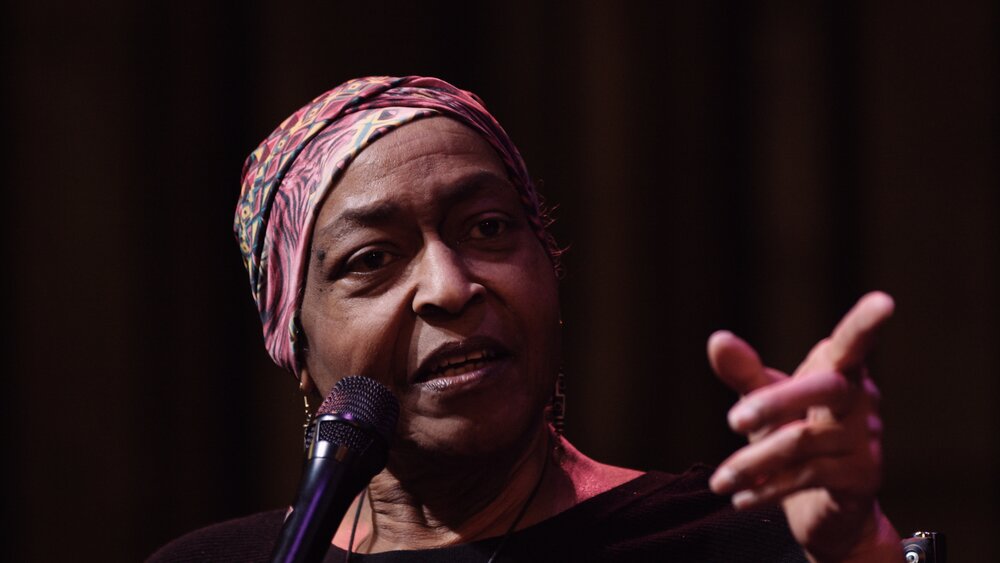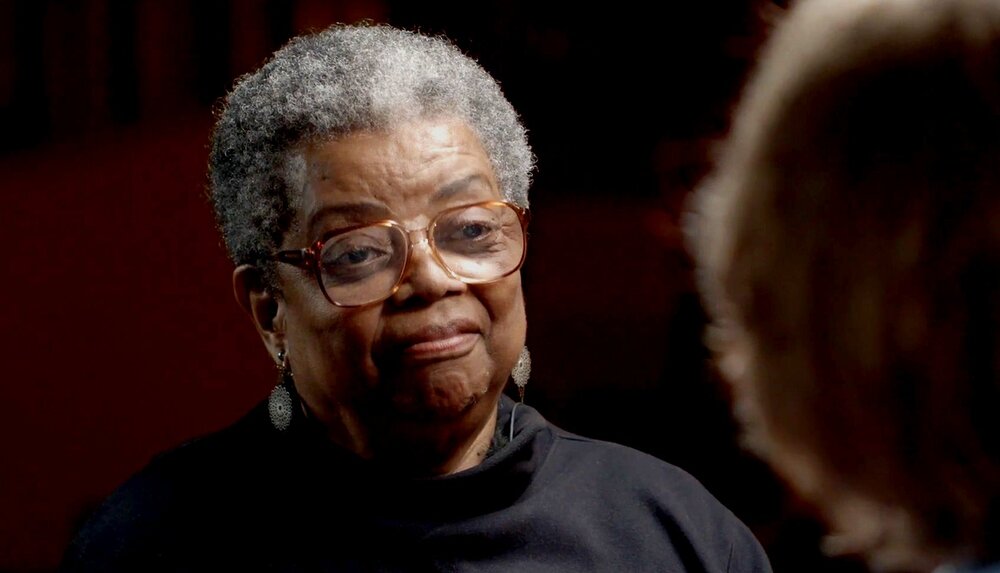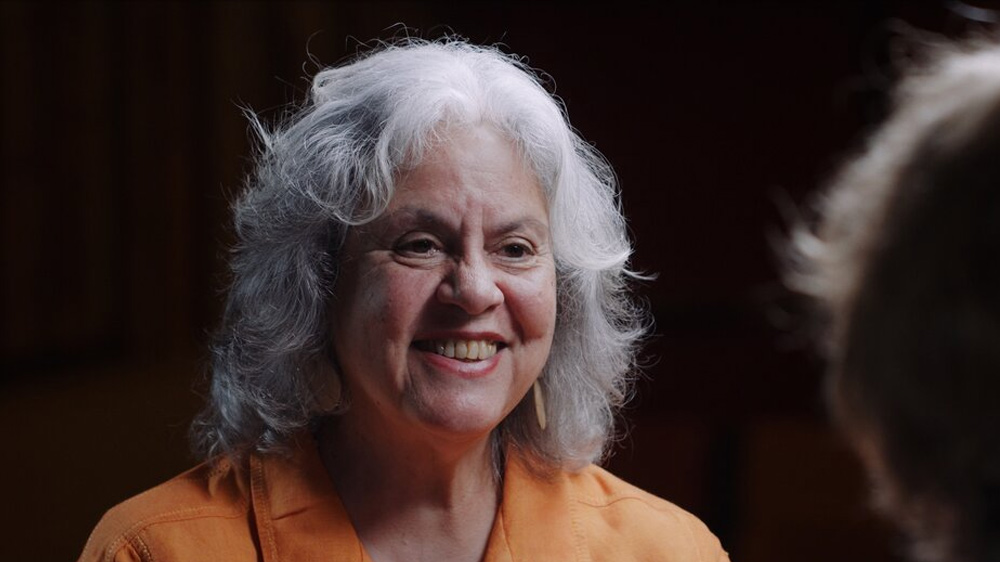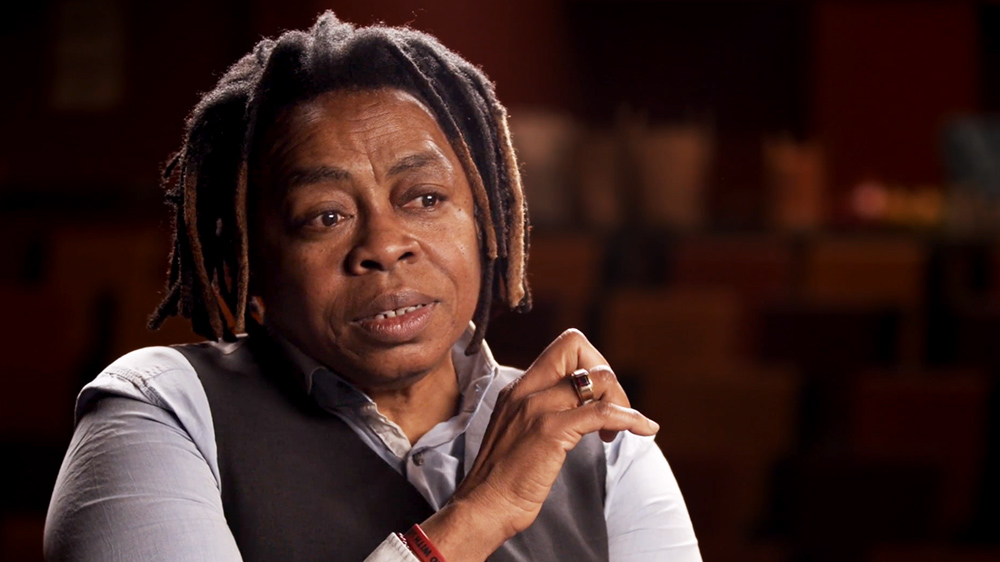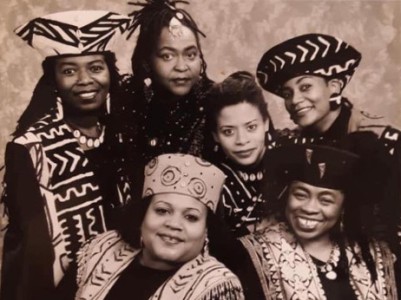
Cultural Heritage Choir
Bottom center: Rhonda Benin, clockwise: Elouise Burrell, Linda Tillery, Rashida Oji, Emma Foster-Fiege, Melanie DeMore.
Photo: Janne Watson
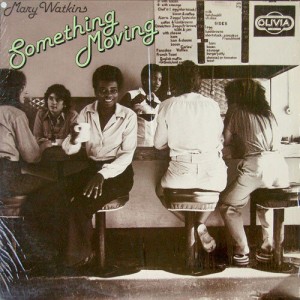
Something Moving
Mary Watkins' critically acclaimed jazz, funk, soul album. Photographed at The Brick Hut.
Olivia Records 1978.
Photo: Lynda Gordon

Melanie DeMore and Mary Watkins
A profound collaboration of piano, voice and spirit.
Melanie DeMore and Mary Watkins.
Photo: Unknown
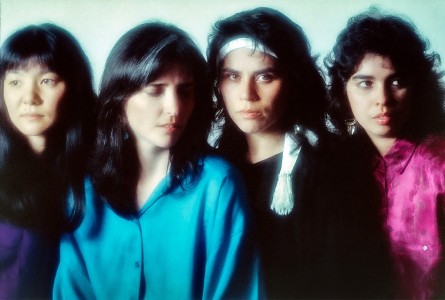
Altazor
Multi-heritage ensemble. (L to R) Asian American Vanessa Whang, Venezuelan Jackeline Rago, Chilean Lichi Fuentes, and Cuban Dulce Arguelles. Album Altazor recorded in 1989, Concurrencia
in 1993. Both produced by Vanessa Whang with Redwood Records.
Photo: Irene Young

Vicki Randle
Singer, multi-instrumentalist and composer. Known as first female member of The Tonight Show band, Vicki has been playing music with women for decades and writing songs that challenge social injustice.
Photo: Irene Young
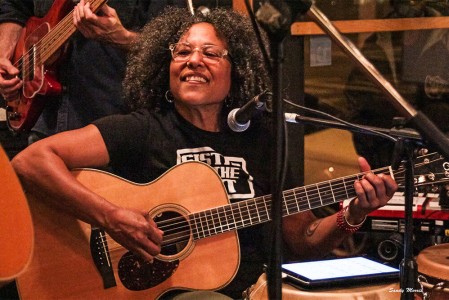
Vicki Randle
Multi-instrumentalist, composer. Member of The Tonight Show band starting with host Jay Leno 1992. Longtime Oakland activist. Founding member of Skip The Needle.
Photo: Sandy Morris

Berkeley Women's Music Collective
(L to R) Nancy Henderson, Suzanne Shanbaum, Nancy Vogl, Jake Lampert, Debbie Lempke.
Outspoken, political contributions to fundraisers and festivals. They independently recorded their first album in 1976.
Photo: Ann P Meredith
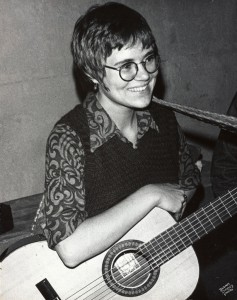
Meg Christian
A central figure in the lesbian/feminist Women's Music movement of the 70's, Meg was among the first to incorporate lesbian themes into her music. She was one of the founders of Olivia Records.
Photo: Diana Davies
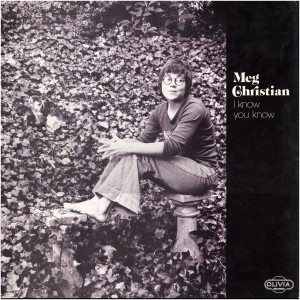
I Know You Know
Meg Christian album which included classics like Gym Teacher, Valentine Song, and Leaping Lesbians (written by Sue Fink).
Photo: © JEB (Joan E. Biren)

Mary Watkins and June Millington
Long before they knew they would become respected elders in Women's Music.
Photo: Unknown
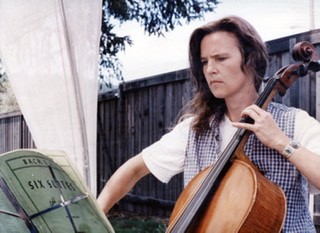
Ann Hackler
Founder of IMA (Institute for the Music Arts) with June Millington.
Photo: Sharon Isabell
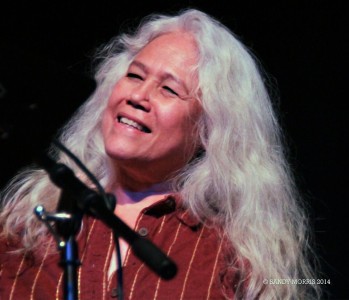
June Millington
Filipina American guitarist, songwriter, producer. Co-founder of all female rock band Fanny.
Photo: Sandy Morris
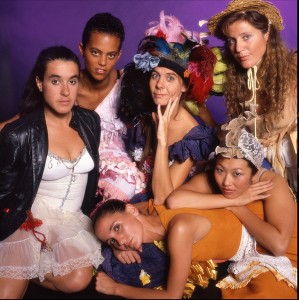
Dance Brigade
Radical feminist dance collective, Dance Brigade used Women's Music in their choreography. L-R: Krissy Keefer, Sarah Crowell, Nina Fichter, Kim Epifano, Maria Pendones
Photo: Irene Young
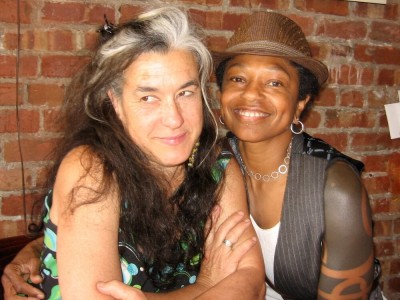
Krissy Keefer and Richelle Donigan
Krissy Keefer, choreographer Dance Brigade, and Richelle Donigan, drummer, life mastery coach and Yoga instructor.
Photo: Unknown
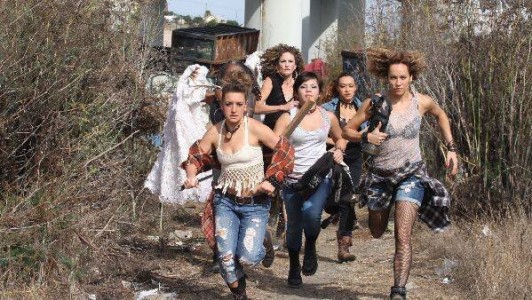
Dance Brigade
Megan Lowe, Sarah Bush, Jillian Hibbert, Tina Banchero and Richelle Donigan.
Photo: Mily Trabing

Chevere circa 1979
Latin Jazz ensemble. Alicia Lo, Flute and Sax; Mary Burnley, Bass; Linda Harris, Congas; Patricia Thumas, Piano/Keys, Co-leader; Nelly Rubio, Vocals and Chekere; Annette Aguilar, Congas, Percussion, Co-leader; Bonnie Johnson, Drums, Percussion, Co-leader.
Photo: Bob Henry. Berkeley
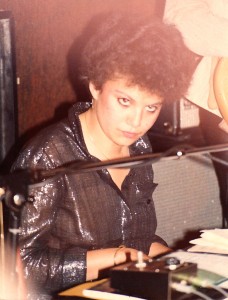
Patricia Thumas
Shown here as member of Chevere in late 70's early 80's, Patricia has been creating salsa/Latin/jazz music for decades. Her newest project is Key Elements, a jazz emsemble that features her own compositions.
Photo: Unknown

Patricia Thumas
Latin Jazz pianist from the 70's (co-leader of Chevere) to the present. She was widely acknowledged as the first woman salsa pianist in the Bay Area. Among other groups she has toured with Blazing Redheads and for 25 years has been performing with El Grupo Sinigual.
Photo courtesy of Precita Eyes
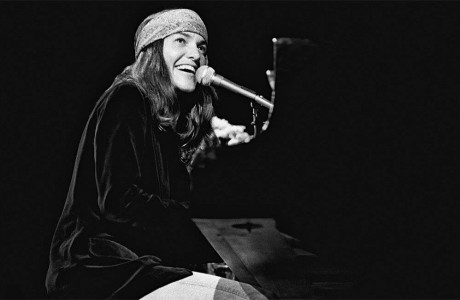
Cris Williamson
Singer/songwriter, she encouraged her friends to start a recording company. It became Olivia Records and in 1975 they released her album The Changer and the Changed.
Photo: Irene Young
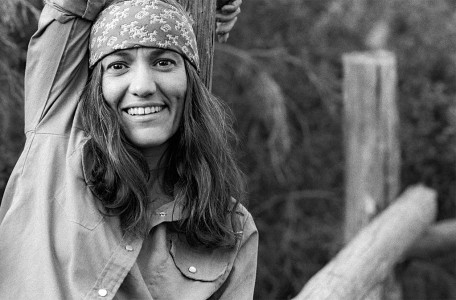
Cris Williamson
Cris went on to record over a dozen more albums following The Changer and The Changed. She has also collaborated with other Women's Music artists including Meg Christian and Teresa Trull.
Photo by Irene Young
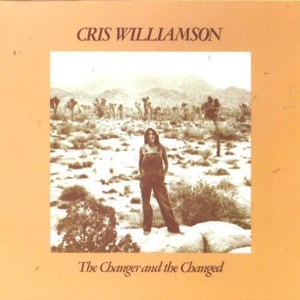
The Changer and The Changed
Album cover by Cris Williamson

Janet Small
Original pianist for all-women jazz group Alive! which formed in the mid-70's. She and other members wrote their own material as well as performing jazz standards. Janet died in 2010.
Photo: Unknown
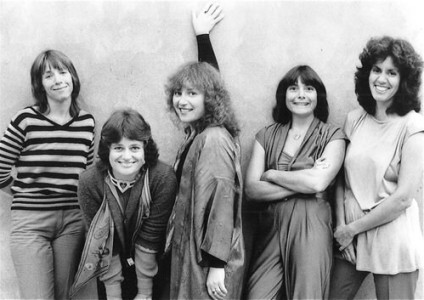
Alive!
The jazz quintet Alive!, the ground breaking all-women's jazz ensemble, was formed in the 70's. The original members shown here are Janet Small, Rhiannon, Barbara Borden, Susanne DiVincenzo, and Carolyn Brandy.
Photo: Irene Young
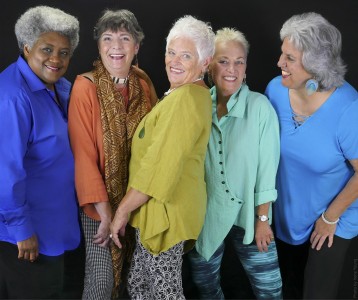
Alive! Reunion
Tammy Hall, Susanne DiVincenzo, Rhiannon, Barbara Borden, Carolyn Brandy. Alive! celebrated the 40th anniversary of the band's founding with a reunion concert at the Freight and Salvage in 2015.
Photo: Irene Young
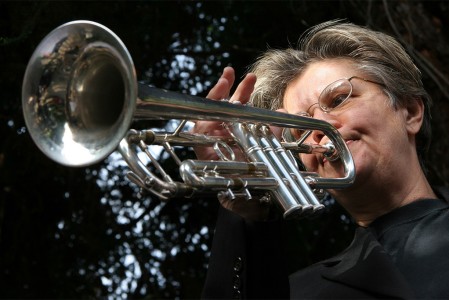
Ellen Seeling
Trumpet player, bandleader, recording artist in jazz, R&B, Latin and pop rock, she formed a jazz fusion band DEUCE with Jean Fineberg. In 1988 she founded the Montclair Women's Big Band which gave visibility to a vibrant Bay Area community of women jazz artists.
Photo: Hali McGrath
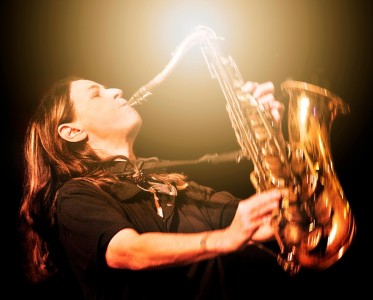
Jean Fineberg
Saxophonist, flute player, drummer and composer, she has toured and recorded with many musicians. With Ellen Seeling she formed jazz fusion band Deuce. And they started all-female summer jazz camps at the Jazzschool in 2009.
Photo: Jane Higgins/Sandy Morris

Teresa Trull
Redwood Records Music Festival.
A pioneer in Women's music, her first album, The Ways A Woman Can Be was released on Olivia Records in 1977.
Photo: J. A. Rubino
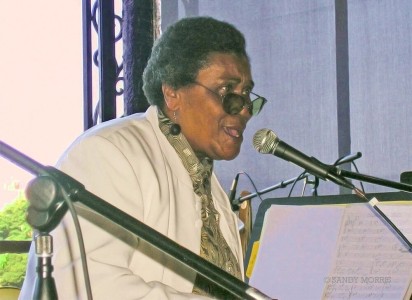
Gwen Avery
Powerful blues singer, rowdy, funny, made great contributions to lesbian community. Died in 2014 age 71.
Photo: Sandy Morris
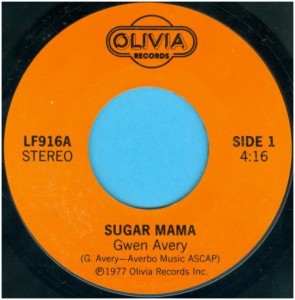
Sugar Mama
Gwen Avery's signature song on Olivia Records label was released as a 45 rpm record.
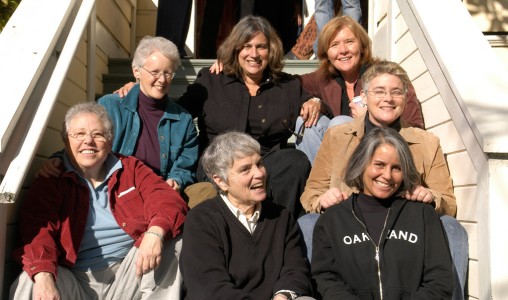
Olivia Reunion Essex St, Oakland 2007
Olivia Records: national women's record company founded by lesbian feminists in 1973 Clockwise from upper center: Judy Dlugacz, Jennifer Woodall, Joan Antonuccio, Robin Brooks, Ginny Z. Berson, Kate Winter, Liz Brown.
Photo: Deborah Hoffmann
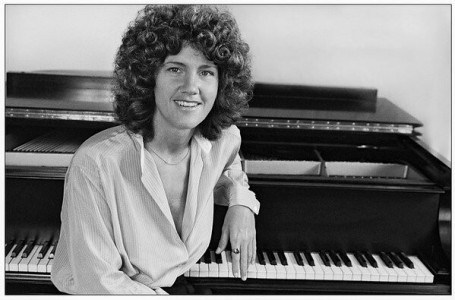
Margie Adam
Feminist singer, songwriter, pianist.
Margie's music goes hand in hand with her life-long commitment to women's rights, health and well-being.
Photo: Irene Young
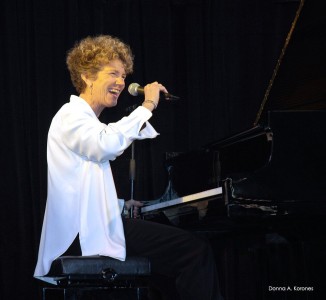
Margie Adam
A Women's Music pioneer, Margie has performed her music at festivals and political events in the early 70's. She founded her own record label, Pleiades Records and released her debut album in 1976.
Photo: Donna A. Korones
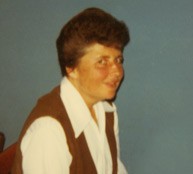
Joan Lowe
Sound Engineer: First woman engineer to work on women's music recordings on west coast.
Photo: Unknown

Linda Tillery and Holly Near
Linda and Holly hang out backstage at the Greek Theater Redwood Records Music Festival.
Photo: Jill Davey
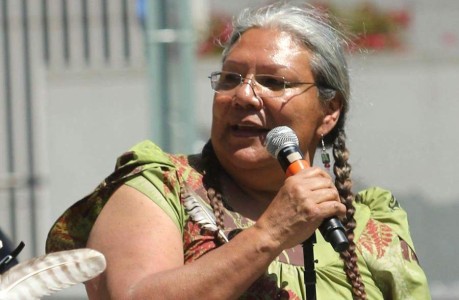
Lakota Harden
Lakota Harden (Minneconjou/Yankton Lakota and HoChunk) is an activist, organizer and elder singer who has been part of Native American struggle for four decades. She has co-hosted a weekly program Bay Area Native on Bay Area radio station KPFA.
Photo: Unknown
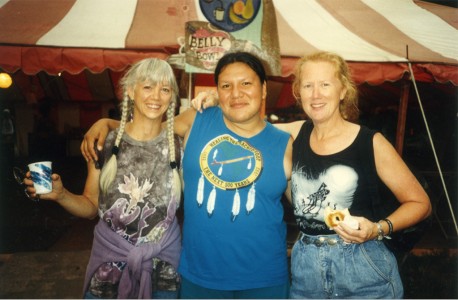
Vicki Noble, Lakota Harden, Holly Near
Snapshot from Michigan Womyn's Musical Festival.
Photo: Unknown
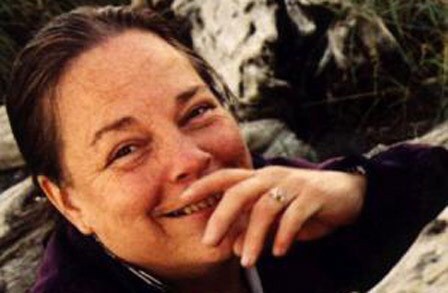
Chrystos
Menominee poet and activist, her writings explore indigenous Americans' civil rights and social justice issues, colonialism, class, and gender. Her work contributed to the consciousness of the Women's Music community An out-spoken lesbian, her personal experiences are woven throughout her testimonial poetry.
Photo: Lieve Snellings.
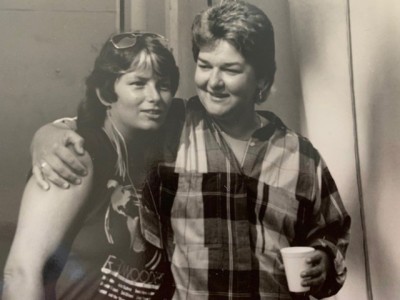
Penny Rosenwasser and Judy Small
Activist, author and organizer Penny Rosenwasser has been a major force in women's music production in the Bay Area. Australian Judy Small, singer songwriter with emphasis on lesbianism, feminism and peace.
Photo: Jill Davey
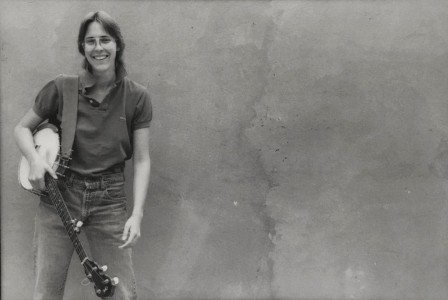
Woody Simmons
Known for her unique banjo style, she appeared on Cris Williamson's Changer and the Changed album in 1975. She then recorded with other artists as well as making her own landmark album Oregon Mountains in 1977 and a CD Mile by Mile in 2008.
Photo: Irene Young
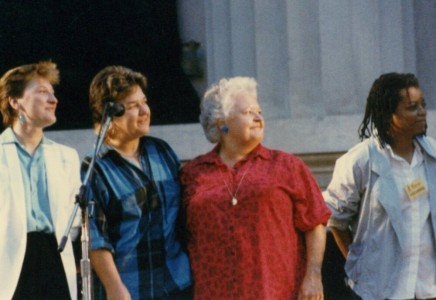
Redwood Records Music Festival
Summer event at the Greek Theater.
Ferron, Judy Small, Ronnie Gilbert, Mary Watkins. Berkeley, CA 1988.
Photo: Unknown

Redwood Records Music Festival
Redwood Records, founded in 1972 by Holly Near, recorded and/or released over 55 albums including Sabia, Nancy Vogl, Judy Small, Victor Jara, Inti Illimani, Sweet Honey in the Rock, Ronnie Gilbert, HARP (Holly, Arlo, Ronnie, Pete), Guardabarranco, Teresa Trull, Salvador Bustos, Connie Kaldor, Mary Watkins, Deuce, Faith Nolan, Altazor, Sisterfire, Ferron, Live from El Salvador, Sotavento, Soul Vibrations, Marcel Khalife, Melanie DeMore,
Keith Terry & Crosspulse, Wild Mango, Street Sounds, Irene Farrera, Carols Valdez and Holly Near

Redwood Staffers
Cynthia Frenz, Suzanne Harkless, Amy Bank.
Photo: Jill Davey
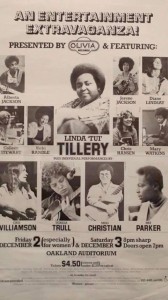
Entertainment Extravaganza
Poster is self-explanatory. All this talent in one place (Oakland Auditorium) for $4.50.
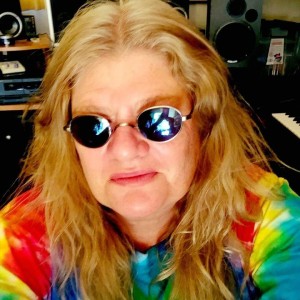
Colleen Stewart
Colleen has been performing on keyboard since the 70's. She was member of the Varied Voices tour on 1978 and frequently accompanied and recorded with Linda Tillery, June Millington and others into the last decade. "I have always felt everything we did was important as we were pioneers in the Women's Music movement."
Photo: Colleen Stewart

BeBe K'Roche
Founded by Pamela (TiiK) Pollet wth L to r: Jerene O'Brien electric guitar and vocals; Peggy Mitchell bass and vocals; Jake Lampert drums and vocals; Virginia Rubino keyboard and vocals.
Photo: Judy Dlugacz
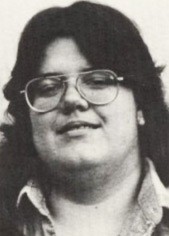
Karen Wallace
Sound Engineer for BeBe K'Roche.
Photo: Shiane Summer-Sky
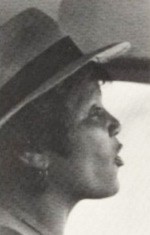
Matu Feliciano
Member BeBe K'Roche.
Photo: Shiane Summer-Sky
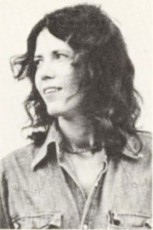
Kim Johnson
Manager,
BeBe K'Roche.
Photo: Judy Dlugacz
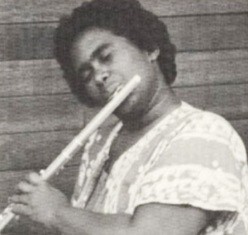
Jasmin Telfair
Member BeBeK'Roche.
Photo: Shiane Summer-Sky
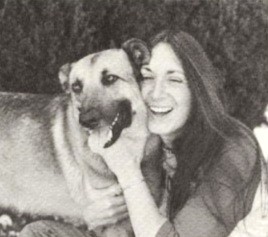
Sandy Stone
Sound Engineer for many Olivia recordings.
Photo: Judy Dlugacz
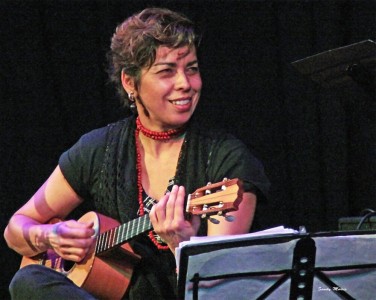
Jackeline Rago
Venezuelan musician who plays cuatro and maracas and other instruments. She is the leader of VNote Ensemble, a quartet that combines jazz and the traditional music of Venezuela.
Photo: Sandy Morris
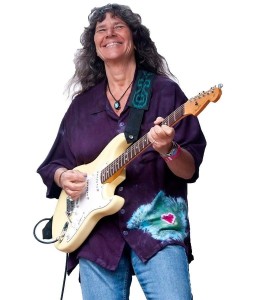
Nina Gerber
"Without a doubt, one of the finest guitar players of our time." -HN
Photo: Robert Hakins

Carolyn Brandy
Leading Sistah Boom. Women's percussion street ensemble.
Photo: Sandy Morris

Sistah Boom
Women Drummers Marching Band founded by Carolyn Brandy. In the streets since 1982.
Photo: Unknown
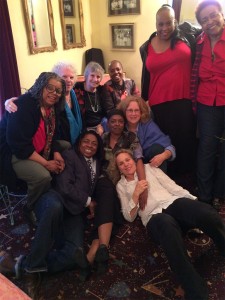
Montclair dressing room
Performers gather in dressing room at Montclair Women's Cultural Club on it's closing night. Mary Watkins, Terry Garthwaite, Alix Dobkin, Sandra Washington, Tammi Brown, Linda Tillery, Melanie DeMore, Sharon Washington, Holly Near, Barbara Higbie
Photo: Unknown
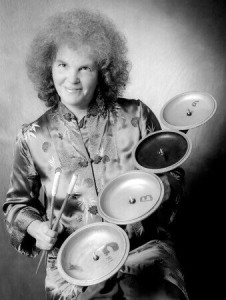
Terry Garthwaite
Founding member Joy of Cooking in the late 60's. Internationally known singer, songwriter, composer, producer, teacher.
Photo: Irene Young
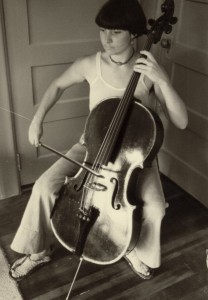
Susanne DiVincenzo
Bass and cello. A founding member of Alive! Women's Jazz Quintet.
Photo: Unknown
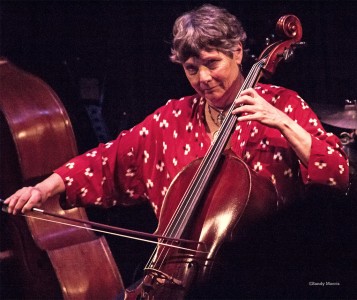
Susanne DiVincenzo
Alive! bass and cello player at the all-women jazz group's reunion at Berkeley's Freight & Salvage 2016.
Photo: Sandy Morris

Faith Nolan Freedom To Love
Canadian folk singer social activist and guitarist presents a mix of African, Mi'Kmaq and Irish heritage. Album cover. On Redwood Records.
Photo: Irene Young
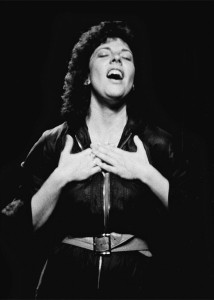
Susan Freundlich
First American Sign Language interpreter to present lesbian feminist music touring nationally with Holly Near. Her groundbreaking work set the stage for all the amazing interpreters who followed.
Photo: Irene Young
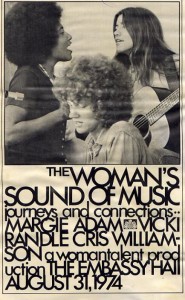
The Woman's Sound of Music
1974 concert .
Margie Adam, Vicki Randle, Cris Williamson.
Photo: unknown
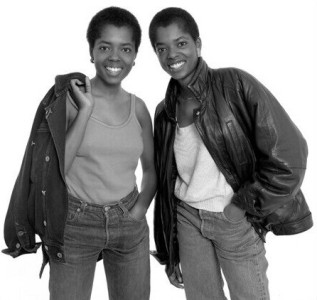
The Washington Sisters
Sandra and Sharon Washington. A twin sister duo with great harmony and humor.
Photo: Irene Young
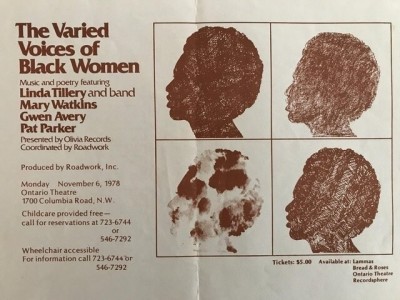
Poster :The Varied Voices of Black women
National Tour 1978
Presented by Olivia Records.
Coordinated by Roadwork
Tour Manager: Konda Mason
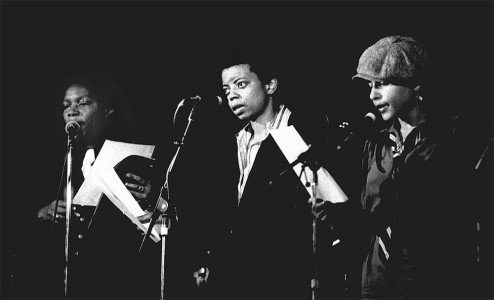
The Varied Voices of Black Women
(R to L) Vicki Randle, Mary Watkins, Pat Parker.
Photo: ©JEB (Joan E. Biren)
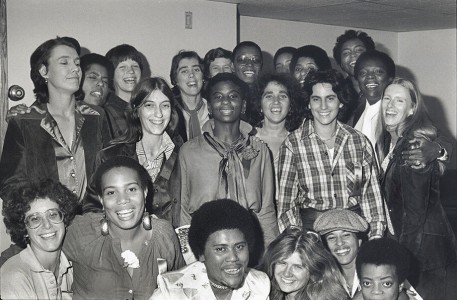
Varied Voices of Black Women
Boston, 1978.
(L to R)
Back Row: Jerene Jackson, Barbara Smith , Polly Laurelchild-Hertig, Tia Cross, Betsy York, Eleanor Johnson, Rhonda Price, Beverly Smith, Linda Tillery.
Middle Row: Emily Blake, Demita Frazier, Barbara Cobb, Judy Dlugacz, Pat Parker, Emily Culpepper.
Front Row: Diane Sabin, Cheryl Jones, Gwen Avery, Colleen Stewart, Vicki Randle, Mary Watkins.
Photo: Susan Wilson

The Varied Voices of Black Women
(R to L) Linda Tillery, Gwen Avery, Vicki Randle, Mary Watkins, Pat Parker.
Photo: ©JEB (Joan E. Biren)
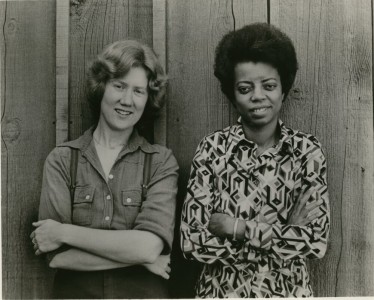
Holly Near and Mary Watkins
Holly and Mary toured together in 1977, including the first Annual Harvest Moon Concert at Grand Valley State College in Allendale, Michigan.
Photo: Amy Horowitz
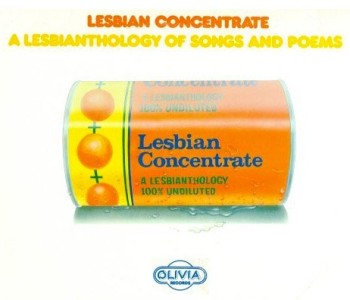
Lesbian Concentrate
Songs and poems in response to Anita Bryant's anti-gay crusade.
Olivia Records 1977.
Designed by Kate Winters
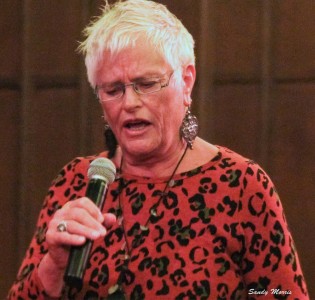
Rhiannon
Vocal artist with a vision of music as a vehicle for innovation, healing, transformation, and social change.
Photo: Sandy Morris
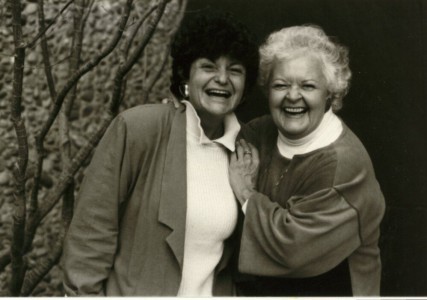
Donna Korones and Ronnie Gilbert
Singer/actor Ronnie Gilbert (right) with partner/manager Donna Korones. Ronnie was founding member of The Weavers. Collaborated with Holly Near. Wrote and appeared in a one-woman show about Irish-American labor activist Mary Harris "Mother” Jones.
Photo: Renee Gaumond

Erika Luckett (August 13, 1965-October 24, 2018)
Mexican musician, member of Wild Mango,
studied in Venezuela and Brazil and performed with partner Lisa Ferraro.
Photo: Hugh Lovell
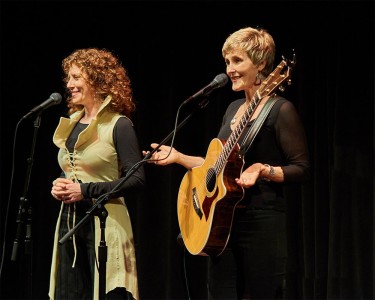
Lisa Ferraro and Erika Luckett
Lisa and Erika performed together since 2006, recording 5 albums.
Photo: Hugh Lovell
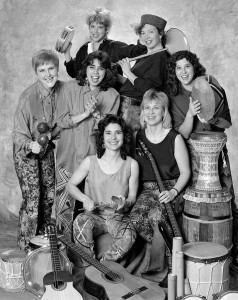
Wild Mango
Beloved veterans of the Bay Area women's music scene, this talented ensemble offered a stylish blend of Latin jazz and world fusion. Far left Erika Luckett; Jackeline Rago (clapping); top left Michaelle Goerlitz; Donna Viscuso(hat); Far right Susu Pampanin; Jan Martinelli; Daria Schwarzschild.
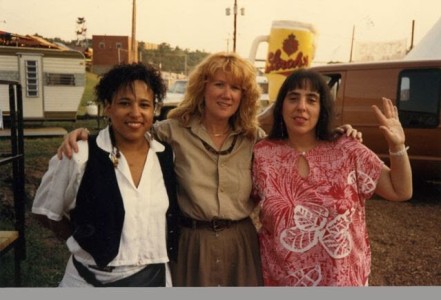
Vicki Randle, Holly Near, Laura Nyro
No idea when or where, but we couldn't resist.
Photo: Susan Frazier

Sweet Chariot Bay Guardian Cover
One of the earliest women's rock bands. Founded in 1972 by Bonnie Johnson and Sharon Russell with Peggy Mitchell. Photo l to r Sue Templeton, Sheila Renee, Sharon Russell, Bonnie Johnson. Other members included Tiik Pollet, Jerene Jackson, Pat Wilder, Alberta Jackson.
Photo: Charly Franklin
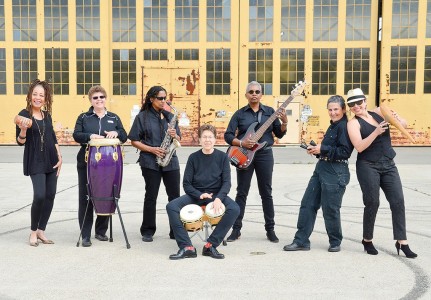
Azucar Con Ache
Bay Area Latin music combo from 2007 to 2017
l to r Maria Cora, Sue Kaye, Robin Nzingah Smith, Judy Graboyes, Mwamba Blakwomyn, Remy Rodriguez, Maria Cetto.
Photo: Cindy Hegger

Azucar Con Ache
All-woman salsa band formed following Azucar y Crema which had been one of the longest running all-women salsa bands in the late 80's.
Remy Rodriguez, Mwamba Blakwomyn, Maria Cetto, Maria Cora, Sue Kaye, Michelle Goerlitz,
Robin Nzingah Smith.
Photo: Sandy Morris
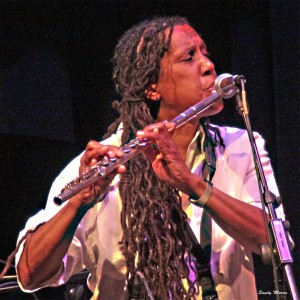
Nzinga Smith
Nzinga brought her versatility on flute or sax to a number of ensembles. Founding member of Azucar y Crema. She is also on faculty of Oakland Public Conservatory of Music.
Photo: Sandy Morris

Bonnie Johnson, Fusion drummer
Co-founder of funk group Sweet Chariot with Sharon Russell. She has toured with Linda Tillery and others, recorded with Meg Christian and Holly Near, and is also a founding member of Latin jazz Chevere. Bonnie has had a long and successful career as a performer and instructor. Photo: Irene Young
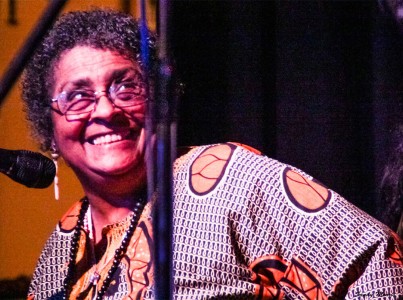
Avotcja Jiltonilro
Poet, playwright, multi-percussionist, teacher. and radio deejay. An award winning poet, Avotcja was the opening act for Pat Parker the last three years of Parker's life.
Photo: Sandy Morris
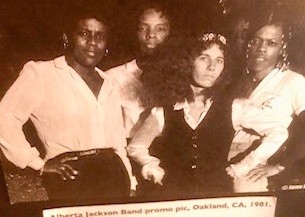
Alberta Jackson Band 1981
Alberta on left with band members Melanie, Jessie, and Laura.
Photo: Unknown
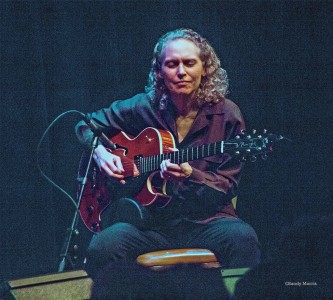
Mimi Fox
Jazz guitarist, composer, educator. Mimi is internationally renowned by writers and colleagues as one of the most eloquent guitarists of her time.
Photo: Sandy Morris
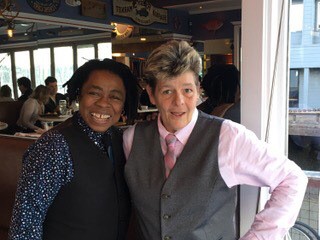
Melanie DeMore and Lynn Haley
Melanie DeMore and concert producer Lynn Haley.
Photo: Unknown
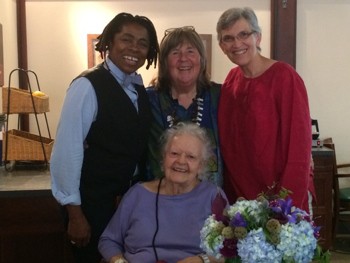
Threshold Choir
Melanie DeMore, Kate Munger (Founder), Cindy Smith, and Ronnie Gilbert. Threshold Choir-singing for those at the thresholds of life in over 200 communities around the world.
Photo: Unknown
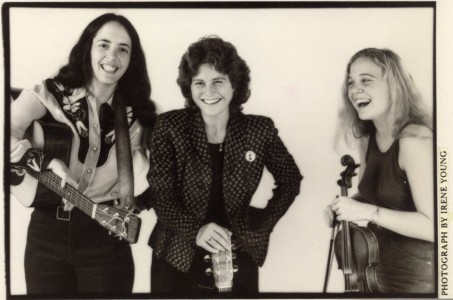
Robin Flower, Nancy Vogl, Barbara Higbie
Bay Area solo musicians making music together or separately since the 70's.
Photo: Irene Young
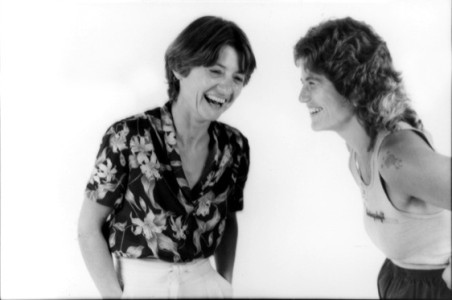
Tess Hoover and Nancy Vogl
Tess: Member of collective that used Bishop’s Senior meals center in Oakland as a weekend coffeehouse, Womanspace to host Women's Music events. It's where she met
Nancy Vogl: Berkeley Women’s Music Collective 1975-1981. Nancy has recorded two albums of her own and toured with Woody Simmons, Robin Flower and Holly Near.
Photo: Irene Young
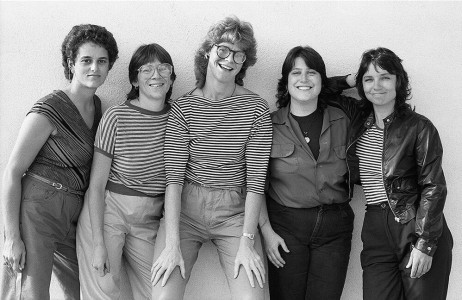
Swingshift 1982
Jazz ensemble. (L to R) Joan Lefkowitz, Naomi Shapiro, Susan Colson, Freida Fine, Bonnie Lockhart. Combining jazz , feminism, and good labor politics.
Photo: Irene Young

Robin Flower and Libby McLaren
Robin and Libby have been serving up their hybrid blend of American and Celtic traditional music around the Bay Area for three decades. They have released seven CDs.
Photo: Irene Young
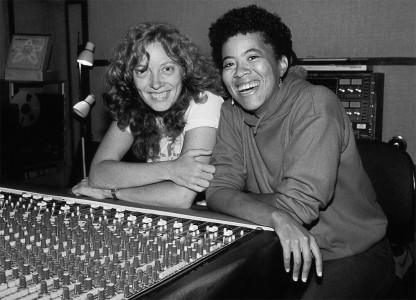
Deidre McCalla (right) and Teresa Trull
Deidre: Contemporary folk musician who celebrates the power and diversity of the human spirit. Teresa: singer, songwriter, producer, she was a recording artist for Olivia Records.
Photo: Irene Young
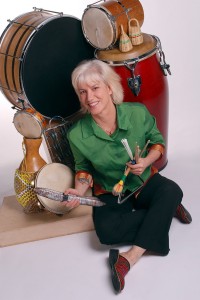
Michaelle Goerlitz
Esteemed percussionist who has performed and recorded with many Bay Area groups and individual artists. Founding member of Blazing Redheads and Wild Mango.
Photo: Irene Young
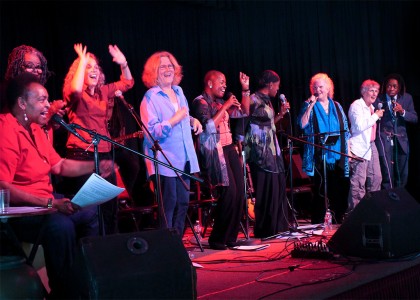
Montclair performers
Final concert at the Montclair Women's Cultural Arts Club in July 2015.
(L to R) Linda Tillery, Mary Watkins, Barbara Higbie, Holly Near, Sandra Washington, Sharon Washington, Terry Garthwaite, Alix Dobkin, and Melanie DeMore.
Photo: Irene Young

Jami Sieber
Acoustic and electric cellist, vocalist and composer. Genre-defying music as a medium to express the interconnectedness of all beings.
Photo: Geoff Manasee
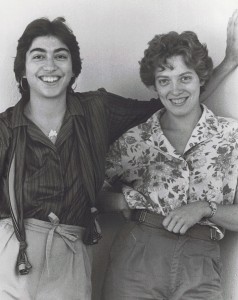
Julie Homi (left) and Teresa Trull
Julie Homi, Londoner who found Oakland. Piano, keyboards and singer/songwriter. Teresa Trull, North Carolinian finds Oakland. Huge voice.
Photo: Unknown
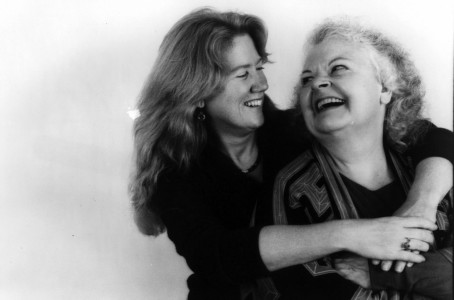
Holly Near and Ronnie Gilbert
Holly and Ronnie: a powerful collaboration of old and new left, lesbian feminism, and multi-generational community.
Photo: Irene Young
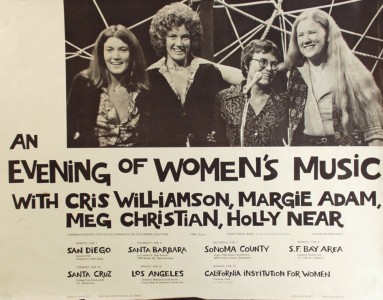
Women on Wheels Concert Tour
Seven cities in California 1976. Poster design: Sue Talbot.
Photo: from KCET-TV concert Come Out Singing produced by Lynn Lipton.
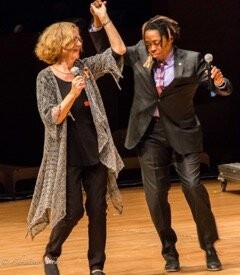
Holly Near and Melanie DeMore
GALA Festival 2016 Boettcher Concert Hall, Denver, CO.
Photo: Unknown
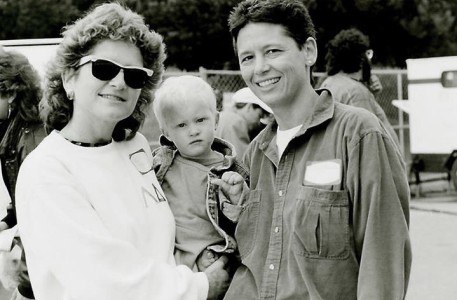
Jeanne Rizzo and Pali Cooper
Pali and Jeanne took a major role in support of same-sex marriage. Jeanne was the owner of the Great American Music Hall, and she welcomed Women's Music with open arms.
Photo: Unknown

Tret Fure
Singer-songwriter Tret Fure has played a prominent role in Women's Music. Singer, songwriter, producer and social change activist.
Photo: Brock Switzer

(L to R) Regina Wells Rashida Oji, Linda Tillery, Melanie DeMore
June 28, 2015 Pride.
Photo: Sandy Morris
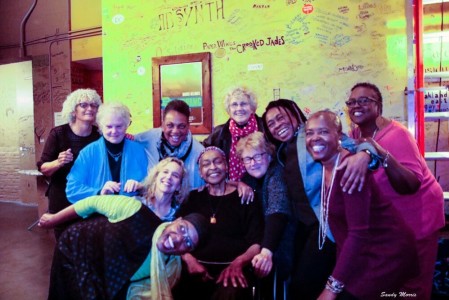
Back stage at Freight and Salvage
(L to R, B to F) Doralynne Folse, Terry Garthwaite, Karen Williams, Margie Adam, Melanie DeMore, Ann Jefferson, Barbarie Higbie, Linda Tillery, Holly Near, Sandra Washington, Sharon Washington.
Photo: Sandy Morris
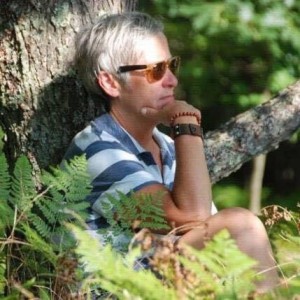
Lisa Vogel
At age 19 founded Michigan Womyn's Music Festival, the largest and longest running all women's music festival in the world for 40 years. An Oakland resident, she brings her working class roots to her passion for the women's community.
Photo: Brynna Fish
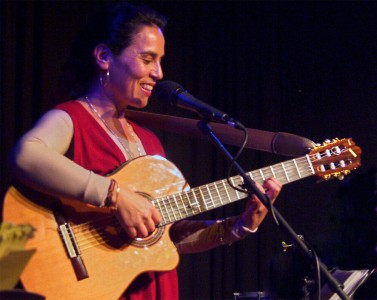
Lichi Fuentes
One of founding participants of La Peña 1975. She sang and played guitar with Grupo Raiz and is director of La Peña community chorus founded in 1978 by Chilean refugees.
Photo: Hugh Lovell
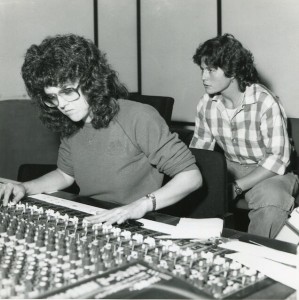
Leslie Ann Jones, Sound Engineer
Recording Holly Near's album Fire In The Rain 1980.
With Nancy Vogl, singer, songwriter.
Photo: Unknown
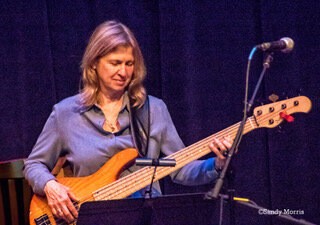
Jan Martinelli
Founding member of Wild Mango.
Longtime musical collaborator with Holly Near.
Photo: Sandy Morris
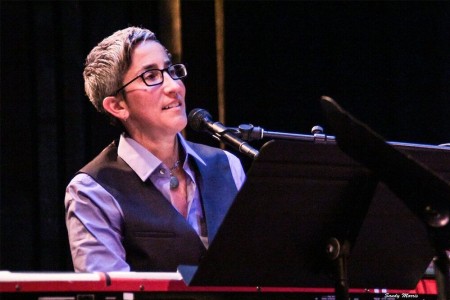
Julie Wolf
Producer, composer, pianist . Her work includes collaborations in dance, poetry and film.
Photo: Sandy Morris
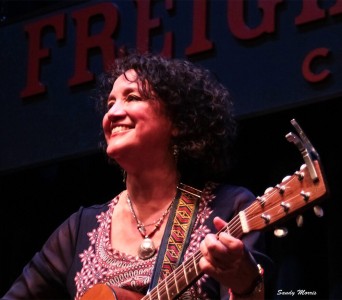
Eve Decker
Singer-songwriter. Practitioner of the dharma since 1991. Founding member of Rebecca Riots.
Photo: Sandy Morris
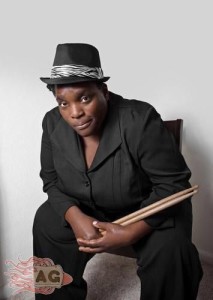
Daria Johnson
Drummer, singer, multi-instrumentalist.
Member of Kofy Brown band. Daria has played with many talented musicians and is a sought-after drummer in the Bay Area.
Photo: Andrew Gallucci
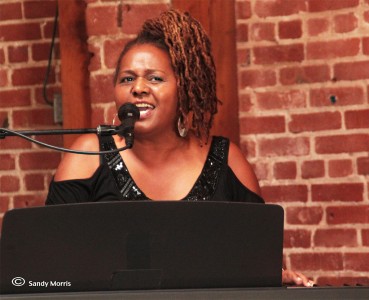
Rita Lackey
Pianist and vocalist in Bay Area jazz and salsa groups for decades. She is also a composer and teacher and performs with her own group Rita Lackey and Friends.
Photo: Sandy Morris
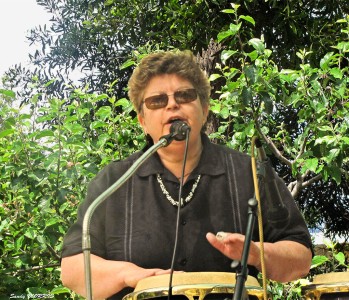
Sue Kaye (Suki)
Percussion in Azucar y Crema, Azucar con Ache and many other ensembles, Suki has been prominent drummer and teacher of African and Latin style for over 40 years.
Photo: Sandy Morris
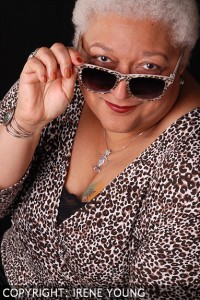
Jewelle Gomez
Author of The Gilda Stories about a black, lesbian feminist vampire. Jewelle's work centers on women's experiences, particularly LGBTQ women of color. She was on the founding board of GLAAD, worked in philanthropy, highlighting the intersection of money and political activism.
Photo: Irene Young.

Diane Sabin (left) and Emily Culpepper
Lifelong lesbian feminist activists who in the early days produced women's music performances. They are shown here during one of their Artemis Production concerts, probably in 1978.
Photo: Ellen Shub

Ferron album: Testimony
One of the finest complex lyricists in Women's Music equal to the mainstream work of Leonard Cohen. Lucy Records.
Released in U.S. in 1980.
Mfg and distributed by Redwood Records.
Photo: James LaBounty
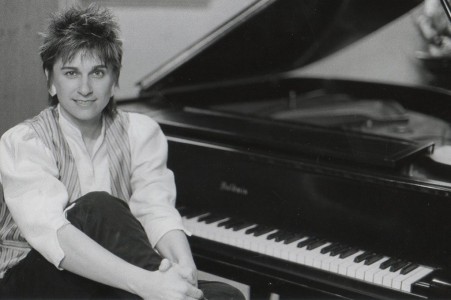
Gayle Marie
A professional singer since 8th grade, Gayle, currently a classical singer and teacher, made several albums in the 80's. Double Talk, released in 1984 was produced by Mary Watkins.
Photo: Unknown
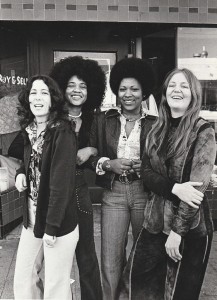
Sweet Chariot
Funk group 1972-1978. (L to R) Bonnie Johnson, Sharon Russell, Sheila Renee, Sue Templeton. Sharon Russell went on to tour with Miriam Makeba as guitarist and back up singer.
Photo: Charly Franklin
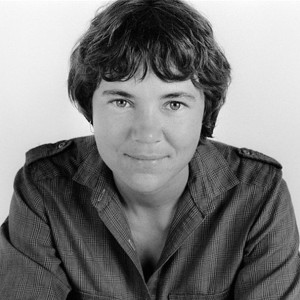
Meg Christian
Singer/songwriter and extraordinary guitarist who coined the phrase "women's music," she is one of the founders of Olivia Records.
Photo: Irene Young
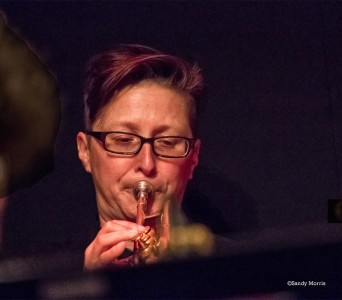
Marina Garza
Trumpeter, singer and composer. Played in Orquesta D'Soul in early 2000's fusing salsa, Latin rock, ska and hip hop. Member of Montclair Women's Big Band and Jazzwomen and Girls Advocates.
Photo: Sandy Morris

June Jordan and Isabel Allende
One of the many panels presented by Redwood Records on art and politics.
Photo: Unknown
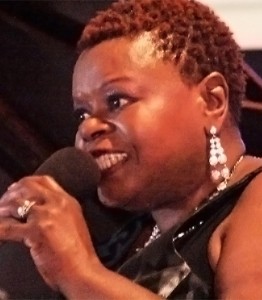
Jazzi Jan
Vocalist with a sultry jazz sound, Jazzi, known for her wide range of vocal skills, is often accompanied by women from the community shown on this scroll.
Photo: Sandy Morris
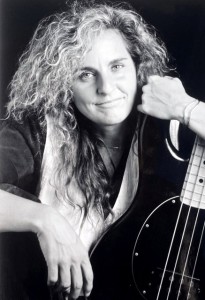
Diane Lindsay
Diane is classically trained pianist, electric bassist, recording artist, producer, arranger and music director. She is composer of "Sweet Darlin' Woman" (recorderd by both Meg Christian and Vicki Randle.) She has produced three albums of her own songs, as well as touring and recording extensively with other artists.
Photo: David Perry
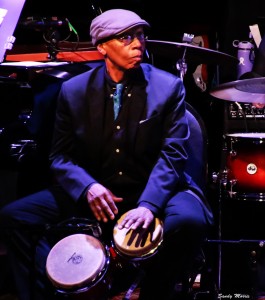
Renaye Brown-Guilartes
Percussionist, bassist. Records, composes, and performs with Bay Area groups, including bongos in the jazz ensemble Mary Lou's Apartment.
Photo: Sandy Morris
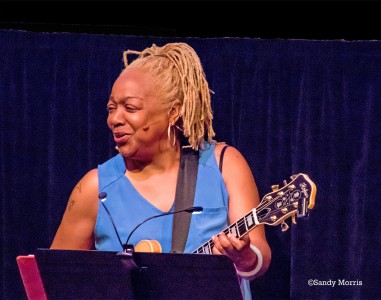
Pat Wilder
Blues guitar and vocals. She performs with jazz and blues ensembles as well as her own gigs of gospel, spiritual, rhythm-and-blues. Photo: Sandy Morris
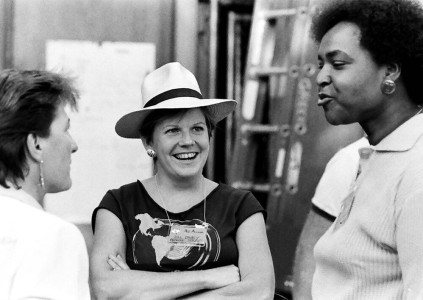
Ferron, Jill Davey, Linda Tillery
Redwood Records Music Festival 1985.
Photo: J. A. Rubino
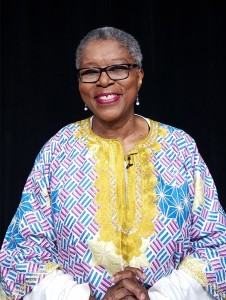
Bernice Brooks
Drummer on many albums including Holly Near's Fire in the Rain 1981.
Photo: Bernice Brooks

Emma's Revolution
Sandy O (left) and Pat Humphries; songwriters who focus on the critical issues in the world and lend their voices to the movements those issues inspire.
Photo: Terry Georgia
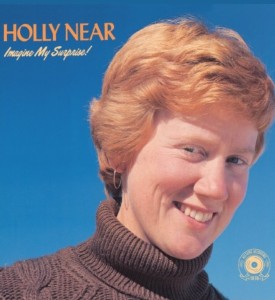
Imagine My Surprise
Widely known in the global social change movement, Holly Near comes out, challenging homophobia in the left and celebrating the courage of the lesbian community.
Album Cover 1978 Redwood Records.
Photo: Tee Corrinne

On Tour
Holly Near, Adrienne Torf piano, Carrie Barton bass, Cam Davis drums circa 1982. Presenting songs from album Fire In The Rain produced by June Millington.
Photo: Irene Young
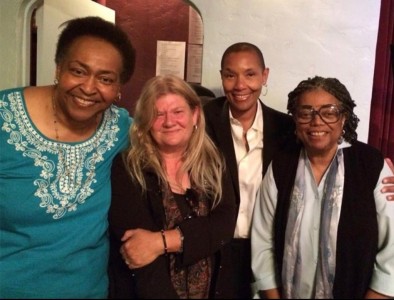
(L to R) Linda Tillery, Colleen Stewart, Rhonda Price, Mary Watkins
Linda, Colleen, and Mary with equipment manager Rhonda Price.
Photo: Unknown
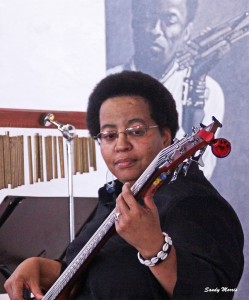
Lillie Robinson
Bass player and guitarist known for her musicality and lyrical playing. She has played with numerous Bay Area women's groups including Blazing Redheads. Teaches at Oakland Public Conservatory of Music.
Photo: Sandy Morris
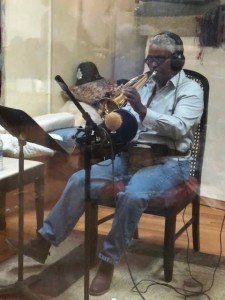
Helena Jack
Jazz musician, Helena has played trumpet and traveled with distinguished jazz artists. She played on Holly Near's album 2018. For the past decades she has been providing quality jazz music education to East Oakland youth.
Photo: Donna Korones

Casselberry (right) and DuPree
J. Casselberry and Jaqu'e DuPree.
Gospel, reggae to jazz, soul and country, this duo performed together for over a decade starting in 1980.
Photo: Diana Davies
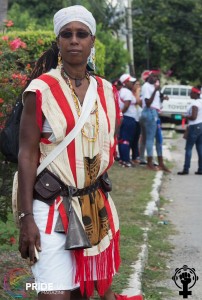
Afia Walking Tree
Educator, ritualist, drummer. Afia is founder of Spirit Drumz.
Photo is from Pride Ja magazine.
Women's Day Survivors March, Kingston, Jamaica March 11, 2017.
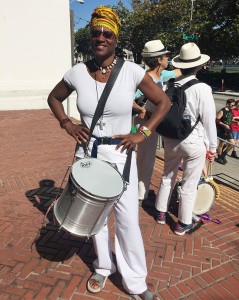
Mar Stevens
Following in Carolyn Brandy's footsteps: Mar Stevens has been leader of Sistah Boom, women's samba marching band, since 2012.
Photo: Unknown

Leela Grant
Drummer. Backbone and founder of Sistas in The Pit, Afro-punk, soul and rock group.
Photo: Sandy Morris
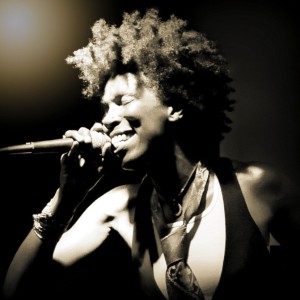
Kofy Brown
Oakland musician, singer-songwriter. Member of Sistas In The Pit and Skip The Needle.
Photo: Irene Young
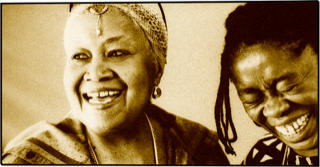
Odetta and Melanie DeMore
Melanie DeMore has shared the stage with many notable musicians, including Odetta.
Photo: Roth and Ramberg
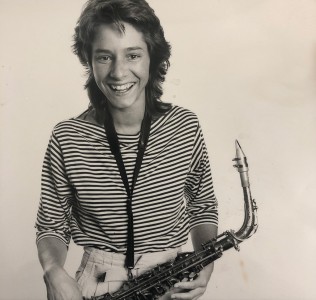
Sapphron Obois
Sapphron , saxophonist, has contributed to a number of ensembles around the Bay. In addition to recording her own jazz album, she has played on the albums of Holly Near, Teresa Trull, Barbara Higbie and many others.
Photo: Irene Young
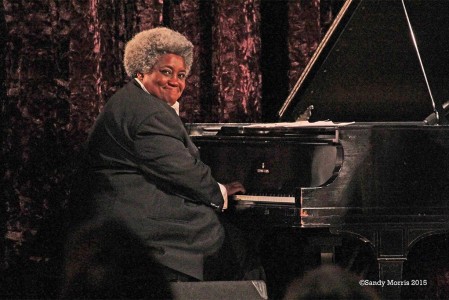
Tammy Hall
From Dallas, Texas Tammy Hall came to Oakland and became one of the most in-demand accompanists. Singers love her. Pianist, teacher,
mentor, composer, prolific in styles from jazz to classical. A powerful soloist, she is co-minister of music at Heart and Soul Center of Light, Oakland, Ca.
Photo: Sandy Morris
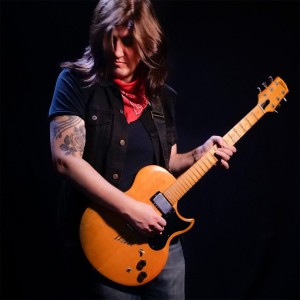
Katie Cash
Oakland singer, songwriter, guitarist. Member of Skip The Needle.
Photo: Irene Young
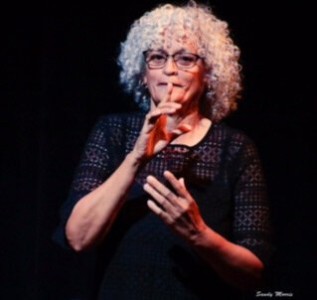
Doralynn Folse
Generous and hard-working sign language interpreter bringing her skill to Women's Music events.
Photo: Sandy Morris
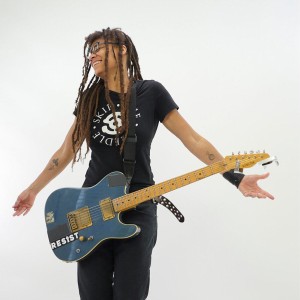
Shelley Doty
Renowned for her guitar playing, Shelley is a singer, songwriter who performs and records her own material as well other musicians'.
She sings and plays guitar in the Oakland based rock foursome Skip The Needle.
Photo: Irene Young
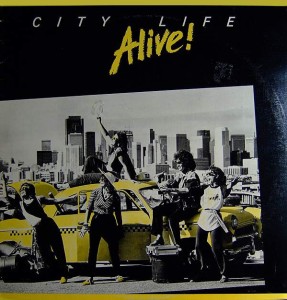
City Life
Alive! Album cover.
On their own label. 1982.
Photo: Sharon Beals
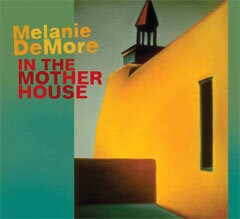
In The Mother House
Melanie DeMore album.
Self-released 2012
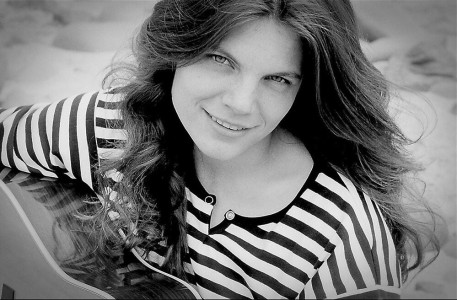
Jennifer Berezan
Singer, songwriter, producer, activist. Her work reflects environmental and feminist perspectives through her Buddhist practice. Moved to N. Calif from Alberta, Canada.
Photo: Irene Young
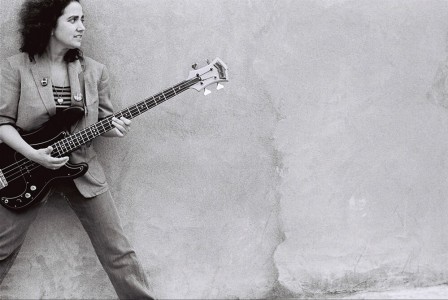
Barbara Cobb
Bass player. Contributed to recordings by Holly Near, Malvina Reynolds, Sirani Avedis, and many more.
Photo: Irene Young

Frances Reid (left) and Liz Stevens
Their film, In The Best Interests of the Children (1977) was a groundbreaking portrayal of lesbian mothering through the stories of eight women of diverse race, class and experience.
Photo: Ann P Meredith
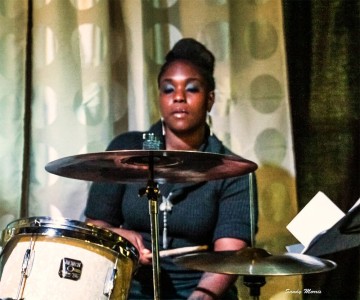
Ruthie Price
Drummer. Next generation musical contributor to the Oakland women’s music scene.
Photo: Sandy Morris

Debbie Fier
Performing vocalist, drummer, pianist, composer, Debbie has also been teaching drumming for over 30 years. Tunes pianos, too.
Photo: Irene Young
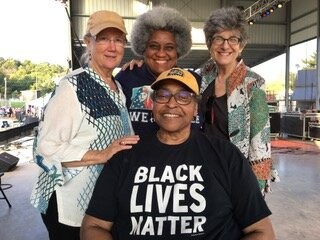
Black Lives Matter
(L to R, Back row) Holly Near, Tammy Hall, Amy Horowitz.
Front: Linda Tillery.
Ohio Lesbian Music Festival 2017.
Photo: Unknown
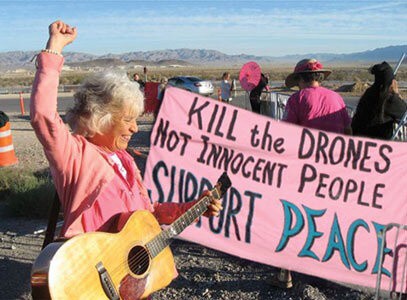
Betsy Rose
Singer, songwriter.
Leading songs with Code Pink at Creech Airforce base, protesting drones.
Photo: Unknown

Barbara (Boo) Price
Founder of Montclair Women's Cultural Club. Concert producer, offering essential support to the Montclair Women's Big Band.
Photo: Unknown
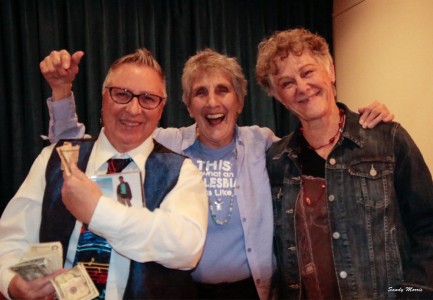
(L to R) Retts Scauzillo, Alix Dobkin, Janet Rachel
Thursday night open mic coordinators at Montclair Women's Cultural Arts Club. First Alix , then Retts, then Janet, they were emcees of the monthly talent showcase for 16 years.
Photo: Sandy Morris
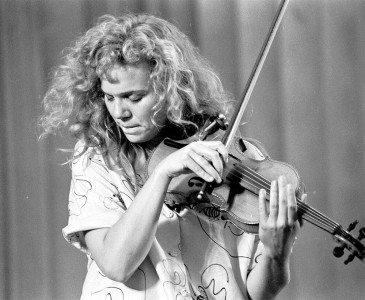
Barbara Higbie
Redwood Records Music Festival 1985.
Born in Africa, Barbara has a deeply rooted understanding of both Afro-centric styles as well as Celtic and classical forms.
Photo: J. A. Rubino
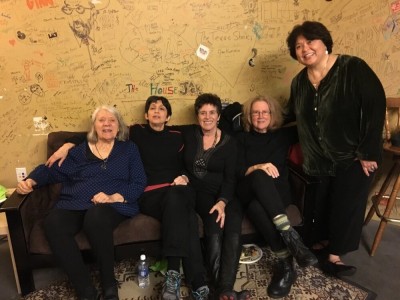
Backstage at the Freight
Hanging out with the iconic Barbara Dane. (L to R) Barbara Dane, Adrienne Torf, Linda Hirschhorn, Holly Near, Elizabeth Seja Min.
Photo: Unknown
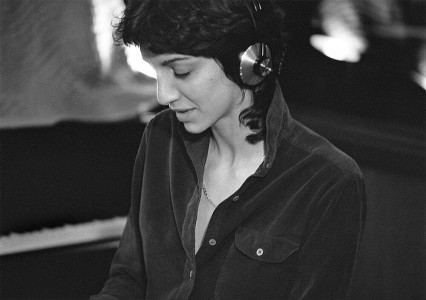
Adrienne Torf
Pianist and composer, Adrienne's keyboard arrangements appear on over 20 albums including two of her own. In 1983 she began a long collaboration with the late poet and activist, June Jordan. June Jordan & Adrienne Torf: Collaboration(Selected Works, 1983 -2000) was released in 2003.
Photo: Irene Young

Chris Webster
Soulful singer, Chris Webster applies her versatile voice to various genres. Besides performing live, she has recorded on over 20 albums on her own or with others.
Photo: Sandy Morris
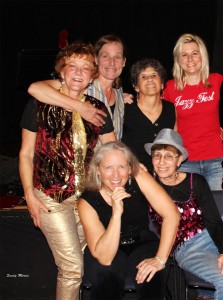
Average Dyke Band
(L to R) Back row: Janet Rachel, Andrea Pritchett, Carrie Gerendasy, Robin Roth.
Front: Suzanne Cimone, Jessie Ortiz.
Photo: Sandy Morris

Karen Soo Hoo
Writer and singer of original material in a blend of jazzy/pop to bluesy rock.
Photo: Sandy Morris
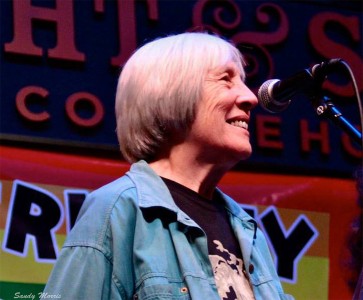
Nancy Schimmel
Singer/songwriter and storyteller for children and adults, Nancy has been an activist for peace and the women's movement since the sixties. With Judy Fjell, she has put on concerts of her mother Malvina Reynold's songs.
Photo: Sandy Morris
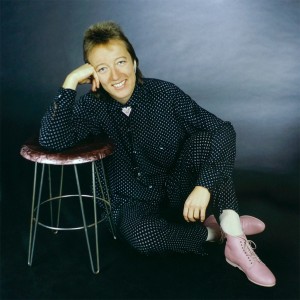
Judy Fjell
During her time in the Bay Areas, Judy has performed in coffeehouses, concert venues, festivals, peace marches and more. She has written over 300 songs and recorded 20 albums. She collaborated with Nancy Schimmel to tour with the songs of Malvina Reynolds.
Photo: Irene Young
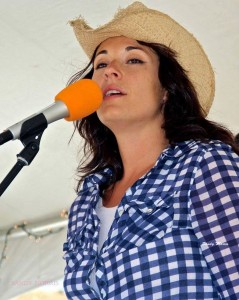
Margaret Belton
Lead singer of her band, The Patsychords, Patsy Cline tribute band. Margaret is an Oakland based singer, actor, artist.
Photo: Sandy Morris

Bad Ass Boots
Oakland band; fun-loving dance, pop, country-rock.
(L to R) Billie Duffey, Joyce Baker, Billie Burnor, Suzanne Cimone, Pat Duffey.
Photo: Sandy Morris
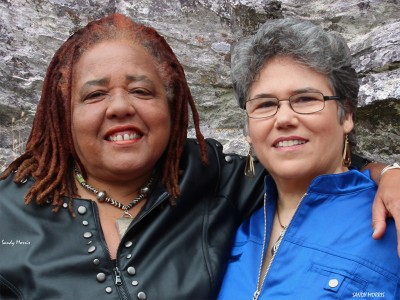
Liquid Girlfriend
San Leandro band into pop, funk, jazzy R&B, rock and indies.
Founding members Linda Atkinson (left) and Cate Larsen.
Photo: Sandy Morris
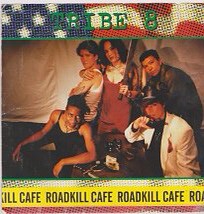
Roadkill Cafe
Album cover for Tribe 8, an LGBTQ punk rock band, one of the first "queercore" groups. 1990 to 2005.
Photo: Chloe Sherman
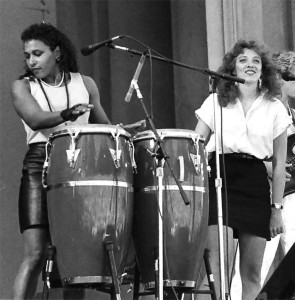
Vicki Randle (left) and Teresa Trull
Veterans of the Women's Music scene since the 70's, Vicki and Teresa perform at the Redwood Records Music Festival, 1985.
Photo: J. A. Rubino
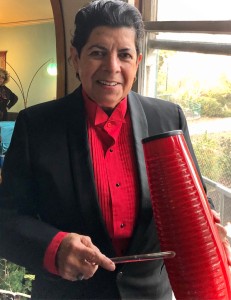
Maria Medina Serafin
Maria "La Sonera del Oeste" is leader of El Grupo Sinigual for over 35 years. She is also a composer of their rich blend of salsa music.
Photo: Jesus Guillen
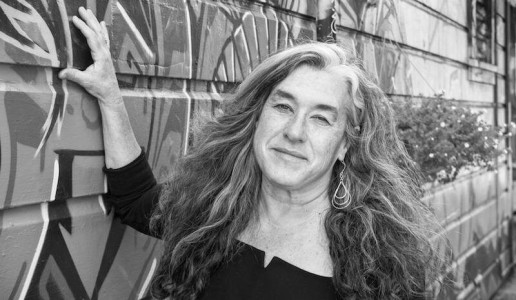
Krissy Keefer
Artistic Director and choreographer of Dance Mission and Dance Brigade, Krissy is a community leader and outspoken environmental activist.
Photo: Unknown

June Bonacich
Classical composer, conductor, teacher.
Baritone in female quartet Out on a Clef.
Photo: Sandy Morris
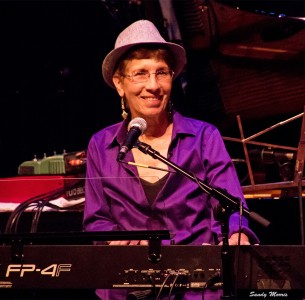
Jessie Ortiz
Plays keyboards with Ruby's In Town. She has been a member of Buddhist Squirrels and played with other local bands including Azucar con Ache. "I like to get people up and dancing."
Photo: Sandy Morris
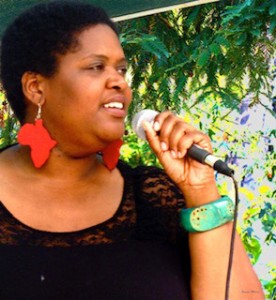
Valerie Troutt
Jazz and gospel trained vocalist, Valerie intertwines art and social justice activism. In addition to her album project The Oakland Girl, she performed with Linda Tillery's Cultural Heritage Choir.
Photo: Sandy Morris

Suzanne Shanbaum
Member of the Berkeley Women's Music Collective in the 1970's, Throughout the 70’s and 80’s Suzanne produced, arranged, and played on other women’s albums or in performances. She later became music director at Ner Shalom.
Photo: Unknown
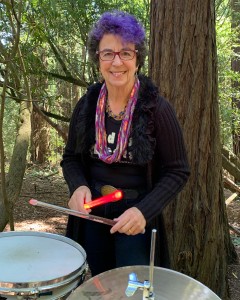
Joyce Baker
Versatile percussionist comfortable in an array of styles. She has recorded with such artists as Sheila Glover, Willow Wray, Jill Rose and the SF City College big band.
Photo: Anne Skeffington

Suzanne Simone
Singer in Average Dyke Band and Bad Ass Boots.
Photo: Sandy Morris
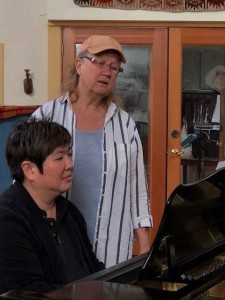
Nancy Hayashibara and Holly Near
Accompanist, Nancy Hayashibara and Holly rehearse.
Photo: Unknown

Nancy Hayashibara
Accompanist and vocal coach, Nancy says
"I use my music, art and writing to tell stories."
Photo: Donna Korones
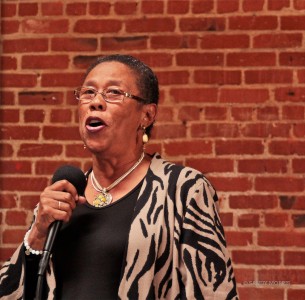
Anna Maria Flechero
Song stylist and jazz vocalist, Afro-Filipina Anna Maria Flechero has had an award-winning career internationally as well as locally. Her style crosses over from the jazz genre into urban/R&B. She recorded the single "Stand Up for Peace", a non-violent call to all to fight for democracy as well as social issues.
Photo: Sandy Morris
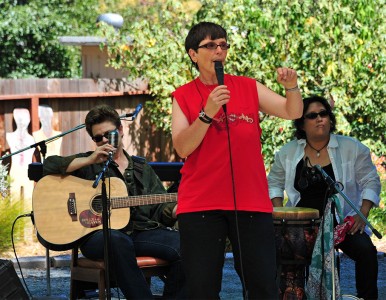
Dvora Gordon
Dvora Gordon (with microphone) Co-Producer of Back Porch Concerts, Oakland 2011. (These were "private events" in the sense that they were not publicized but open to anyone who got word of them through Facebook or by word of mouth and made a reservation.)
With Holly Heaven (left) and Karen Soo Hoo.
Photo: Unknown
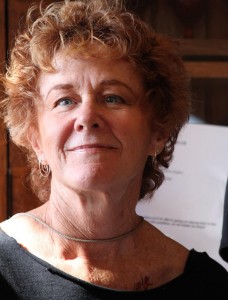
Janet Rachel
Member of lesbian barbershop satire quartets Alternative Measures and Out On A Clef.
Co-producer of The Space which presented music events in Oakland.
She also ran the Third Thursday Open mic at Montclair Women's Cultural Center for 7 years.
Photo: Sandy Morris
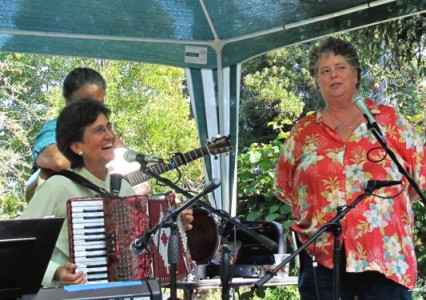
Jan Herzog
Co-Producer of Back Porch Concerts, local events featuring local musicians, publicized by word of mouth and then social media. Jan (standing) is introducing Libby McLaren and Robin Flower.
Photo: Sandy Morris
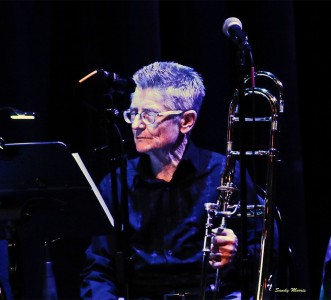
Pat Mullan
Trombonist. Co-founder of Marylou's Apartment, 13-piece all-women jazz ensemble with focus on the compositions and arrangements of Melba Liston and Marylou Williams.
Photo: Sandy Morris
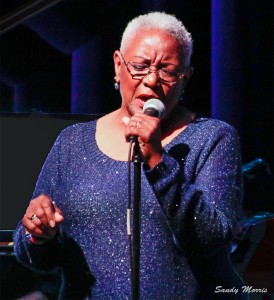
Deborah Tisdale
Vocalist in Marylou's Apartment, Deborah has a background in classical, traditional and progressive sacred music.
Photo: Sandy Morris
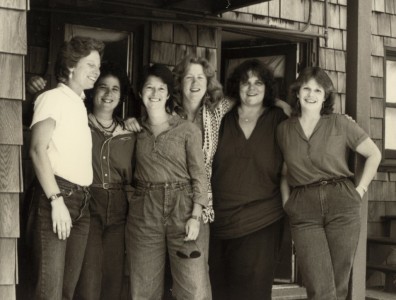
Redwood Records staff
(L to R) Loey Powell, Amy Bank, Joanie Shoemaker, Holly, JoLynne Worley, Jill Davey.
Photo: Unknown

Redwood Cultural Work Sweatshirt

Mwamba Blakwomyn
Performing here with Salsa y Sol. Multi-instrumentalist Mwamba Blakwomyn is co-founder of Mary Lou's Apartment and was a member of Azucar con Ache.
Photo: Celenia Delsol
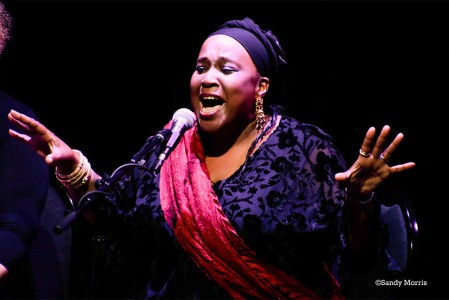
Tammi Brown
Member of The Cultural Heritage Choir, Tammi has also performed on her own with many notable artists in the world of jazz. She is featured vocalist of the award-winning group Lost American Jazzbook.
Photo: Sandy Morris

Angela Wellman
Founding director of the Oakland Public Conservatory of Music, making music instruction accessible to underserved communities.
Photo: Angela Wellman

Angela Wellman
An award winning trombonist, Angela has toured with noted jazz musicians and performed locally with El Grupo Sinigual. She is the founding director of Oakland Public Conservatory of Music.
Photo: Susan Fan-Brown
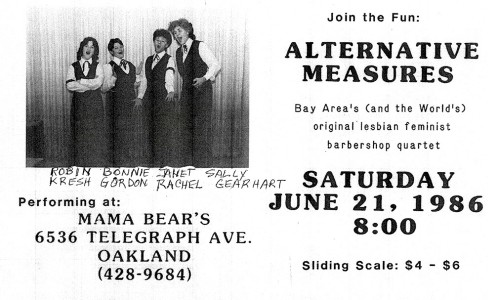
Alternative Measures
Lesbian feminist barbershop quartet.
Robin Kresh, Bonnie Gordon, Janet Rachel, and
Sally Gearhart.
Photo: Unknown
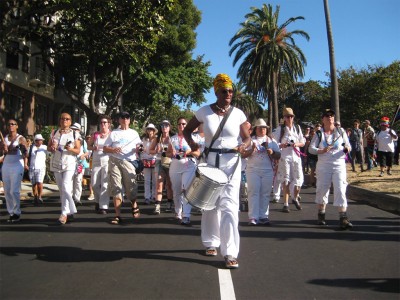
Mar Stevens
Leading Sistah Boom, women's marching band.
She also performs with Sistahs of the Drum, an Oakland based ensemble of women of African descent.
Photo: Unknown
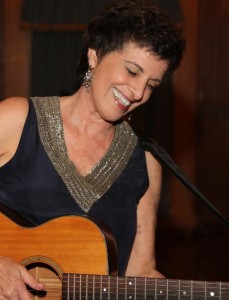
Linda Hirschhorn
Singer, songwriter, performer, cantor, choral director. Linda directs Vocolot, a contemporary Jewish women's a capella ensemble.
Photo: Heidi Kolden
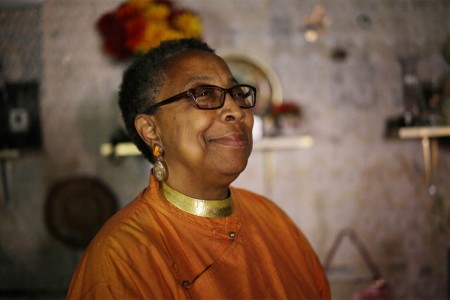
Stephanie Anne Johnson
Eminent lighting designer of public art installations and performance art, Stephanie has been lighting women's productions since the 70's. She worked on Holly Near's Imagine My Surprise in 1978.
Photo: Joan Osato
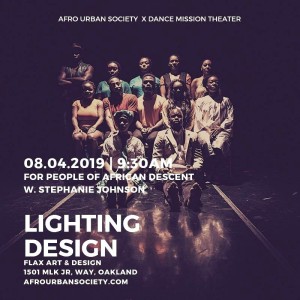
Lighting Design Workshop
Stage lighting technical fellowship for people of African descent under the direction of Stephanie Anne Johnson. This year-long training program was sponsored by Dance Mission and Afro Urban Society.

Skip The Needle
(L to R) Kofy Brown, Vicki Randle, Katie Cash, and Shelley Doty. Alt rock/funk band that plays their own original songs with a high-energy message of joy, love and justice.
Photo: Bill Evans
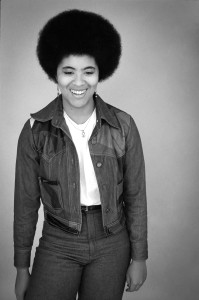
Deidre McCalla
Singer-songwriter in folk and women’s music circles, recorded with MaidenRock and Olivia Records. Photo: Irene Young
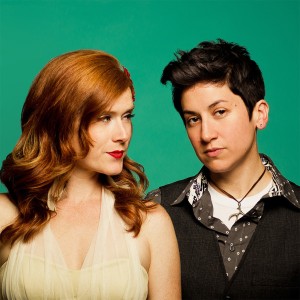
Mouths Of Babes
Ingrid Elizabeth (left) and Ty Greenstein singing out for social change. Folk Pop lesbian duo from Berkeley, CA.
Photo: Sophie Spinelle @ Shameless Photography
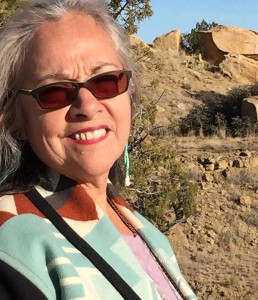
Odilia Galvan Rodriguez
Poet, editor, activist, Odilia has produced seven volumes of poetry. Her recent The Color of Light offers poems dedicated to the Mexica and Orisha Energies. It cannot be over stated the influence that poets had on Oakland culture including Women's Music. Co-editor of an anthology Poetry of Resistance Voices for Social Justice.
Photo: Eldrena Douma
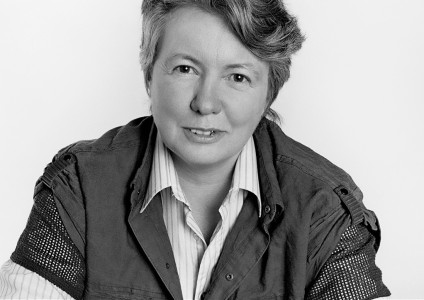
Judy Grahn
"A Woman Is Talking To Death" and "The Common Woman Poems" and non-fiction Another Mother Tongue: Gay Words, Gay Worlds. These are among the foundational works of Judy Grahn that fueled cultural feminist, gay, and lesbian activism since 1965. Poet, activist and scholar, Judy was a co-founder of Women's Press Collective , which in its early days occupied the basement of Oakland's A Woman's Place bookstore. She is an internationally acclaimed poet who we like to think of as "ours".
Photo: Irene Young
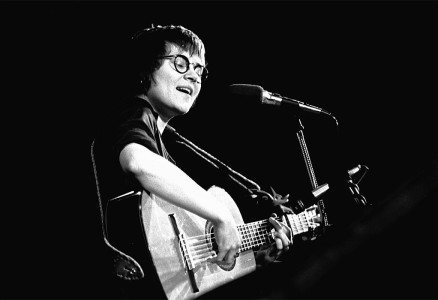
Thank you, Meg!
Photo: ©JEB (Joan E. Biren)


